How to identify and get rid of blue bottle flies

The fly that can smell death
Have you ever seen a slow, buzzing blue blob flying through your home? This isn’t some overly obese fly. No, this is the telltale sign of a blue bottle fly. These metallic blue flies are more than just a nuisance—they’re often a sign that something is rotting nearby, like food waste or even a dead animal.
Blue bottle flies are so good at smelling when something has died that they often land on a dead body within just a few minutes of death. They then lay their eggs in a hole in the carcass or on rotting meat, feces, or garbage, and the maggots hatch and begin chowing down on whatever decaying matter they happen to be on. After a few days, they pupate in the soil and wait for a few weeks before emerging as adults. Blue bottle flies can go from egg to fully mature adult in as little as 21 days!
How to identify blue bottle flies
Blue bottle flies are easy to identify. They have shiny, metallic blue bodies and large, bright red eyes. You can’t miss their loud buzzing noise when they are in the house. These flies are about twice as large as common houseflies, making them stand out.
How big are blue bottle flies?
Blue bottle flies are typically about 1/4 to 1/2 inch long.
Where do blue bottle flies live?
They are found throughout the United States. You’ll find them near trash bins, compost piles, or any decaying organic matter. Indoors, they’re often attracted to food waste or dead animals.
How to get rid of blue bottle flies
Since blue bottle flies are strong fliers and are searching for something dead and decaying, you have two ways of dealing with them:
- Seal up your home - Make sure windows, doors, and any potential entry points are sealed to prevent flies from getting inside.
- Get rid of where they lay eggs - Keep trash bins tightly sealed, clean up food waste promptly, and make sure compost piles are properly managed. If you notice a large amount of blue bottle flies buzzing around your home, you may have a dead animal or rotting waste nearby. Check under your home, near outbuildings, or in hidden areas outside.
One of the best ways to prevent blue bottle flies from coming into your home is by spraying and maintaining a bug-barrier. Pestie offers a pro-grade DIY solution that is easy to apply in just minutes for year-round protection.
Treat blue bottle flies with Pestie
If you're still having trouble keeping blue bottle flies away, the best option is to use a pro-grade, effective pest control solution like Pestie.
Pestie is a do-it-yourself pest control solution that's specially designed to keep blue bottle flies and other pests away from your home.
With Pestie, you can rest easy knowing that your living space is protected and free of creepy crawlies. And the best part? It's designed for people, pets, and the planet, so you can say goodbye to harsh chemicals and hello to peace of mind!
- Save hundreds compared to traditional annual pest plans
- People, pet, and planet-friendly
- Pro-grade customized formulas
Quick facts
How dangerous are Blue Bottle Flies?
Medium danger risk
While they don’t bite, blue bottle flies can spread bacteria and sickness, contaminating food and surfaces they land on.
- Scientific name
Calliphora vomitoria
- Other common names
Orange-Bearded Blue Bottles, Bottlebees
- Colors
Metallic blue
- Life span
2-4 weeks
- Diet
Decaying organic matter
Blue bottle flies are very important in homicides and forensics. Since they are the first insects to arrive on a freshly dead corpse, the eggs and larvae can be used to determine the time of death of a victim.








